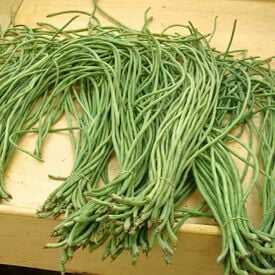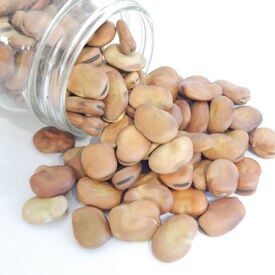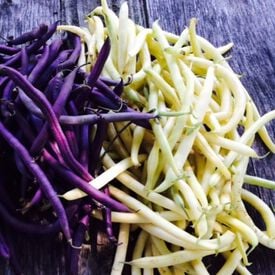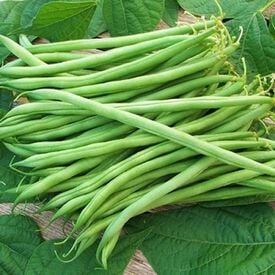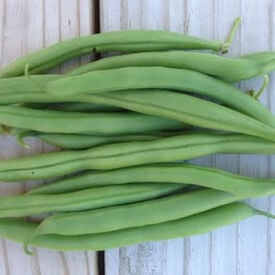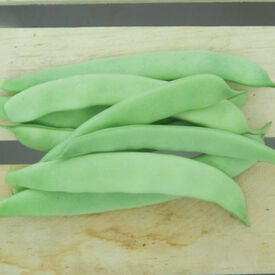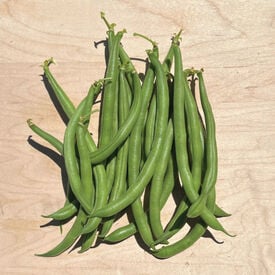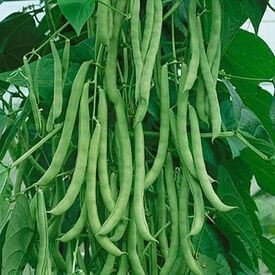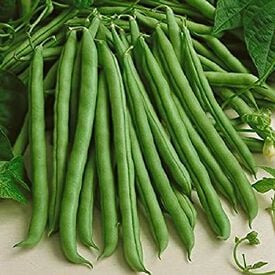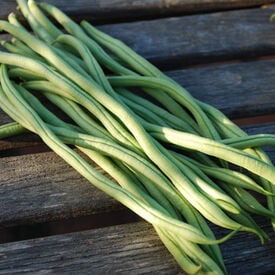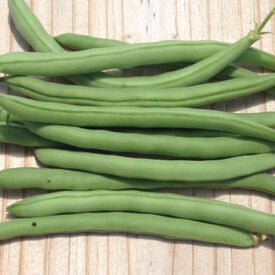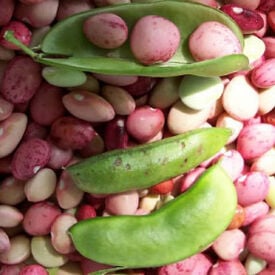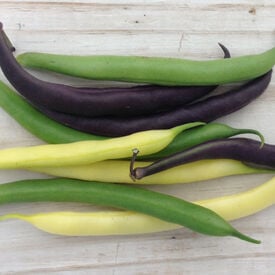Learn More
Amarillo beans (Frijol Amarillo) are a beloved heirloom variety in Mexican cuisine, known for their golden-yellow color and slightly sweet, earthy flavor. These beans are medium-sized, with a smooth texture that makes them perfect for use in a variety of traditional dishes, such as stews, soups, and frijoles de la olla. Their subtle flavor and creamy consistency when cooked make them a versatile ingredient in both savory and vegetarian meals. Grown primarily in the central and southern regions of Mexico, Amarillo beans are well-suited to a range of climates and soil types, offering resilience and a reliable yield. As an open-pollinated variety, they are ideal for sustainable farming practices and seed-saving, ensuring that this flavorful and nutritious bean continues to play an essential role in both Mexican agriculture and cuisine.
A beautifully bright and vibrant green bean that grows extra long when mature! Matures quick and has a delicious and crisp bite.
Fava Broad Windsor beans, also known as Vicia faba 'Broad Windsor,' are a classic heirloom variety with a storied history and a range of notable characteristics. Originating in the United Kingdom, this variety has been cultivated for centuries and is particularly valued for its large, hearty beans and reliable yield. The plants are characterized by their robust growth habit, reaching heights of 24 to 36 inches, with broad, dark green leaves and striking white flowers often tinged with purple. The beans themselves are large and plump, typically encased in thick, protective pods that turn from green to a rich brown as they mature. Fava Broad Windsor beans are known for their creamy, slightly nutty flavor, which becomes more pronounced when the beans are cooked. The plants generally bloom in late spring to early summer, and the beans are usually harvested about 80 to 90 days after sowing. They thrive in cool, well-drained soil and prefer full sun to partial shade. The robust nature of the plants and their ability to fix nitrogen in the soil make them a valuable crop for improving soil fertility in rotation systems. With their rich flavor, historical significance, and agronomic benefits, Fava Broad Windsor beans are a cherished choice for both traditional and modern gardens.
The Mardi Gras Blend is almost too pretty to eat! These fun bright yellow and purple semi flat bean pods are a favorite among home chefs. The Mardi Gras Blend sets a heavy crop of delicious nutty beans. These organic heirlooms are a fun way to get beneficial nutrients.
Seychelles beans are a vibrant and unique variety of green beans, renowned for their striking appearance and exceptional flavor. These beans are characterized by their slender, bright green pods, which typically grow to around 5 to 6 inches in length. The plants are known for their vigorous, climbing growth habit, making them ideal for vertical gardening with the support of trellises or poles. Seychelles beans are praised for their crisp, tender texture and slightly sweet, fresh taste, which enhances a variety of dishes from salads to stir-fries. They thrive in warm weather and full sun, growing rapidly and producing a bountiful harvest. Additionally, Seychelles beans are noted for their resilience and ability to adapt to different soil conditions, ensuring consistent and reliable yields. Their distinctive look and delicious flavor make Seychelles beans a standout choice for gardeners looking to add both beauty and taste to their vegetable gardens. All American Selection winner. Seychelles bean plants typically reach a height of 6 to 8 feet, making them well-suited for climbing and requiring support from trellises or poles. They are a productive variety, with a relatively quick turnaround from planting to harvest. The beans usually mature in about 55 to 60 days from sowing, providing a bountiful and consistent crop in a relatively short growing period. This combination of height and fast maturity makes Seychelles beans an excellent choice for gardeners looking to maximize space and enjoy a swift harvest.
The Landreth Stringless bean is a very old heirloom that debuted by D. Landreth Seed Company in the late 1800's. A meaty bean, very flavorful, stringless bean and produces heavy yields. The pods are medium green in color and a little over 5” long. The seeds are a rich chocolate or coffee brown. This bean is excellent for the home garden, market garden and canner.
The Slenderette bean is an improved Blue Lake bean. So, so good! The Slenderette bean is slow to become fibrous, giving it a quality that in unmatched by any other bean. Stringless. We found it to be very prolific in our test garden. Fast maturing and small seeds when picked for fresh eating. Very straight pods that look great for market selling. Excellent bean, high yields and straight pods.
Roma II beans, also known as Romano beans or Italian flat beans, are a popular variety of green beans known for their exceptional flavor and unique appearance. These beans have a rich history dating back to ancient Rome, where they were cultivated and enjoyed for their culinary versatility. Roma II beans are distinct from traditional green beans due to their flat, wide pods and are favored by many for their tender, meaty texture and delicious taste. The taste of Roma II beans is often described as nutty and slightly sweeter than regular green beans, making them a sought-after choice in various culinary dishes. These beans are typically harvested when they are about 4-6 inches long, ensuring optimal tenderness and flavor. The plants of Roma II beans are known to be vigorous and can reach a height of about 18-24 inches. They have a relatively short maturity period, usually taking around 60 days to reach harvest readiness from the time of planting. The pods of Roma II beans are typically a vibrant green color and can grow to be 5-6 inches long. Roma II beans are prized for their resistance to common bean diseases, including common mosaic virus, rust, and bacterial brown spot, which can help ensure a healthy harvest. When properly cared for, these plants can yield a bountiful crop. For optimal growth, Roma II beans should be spaced about 3-4 inches apart in rows that are 18-24 inches apart. They thrive in well-drained soil and require full sun exposure, making them a great addition to any home garden or farm. Overall, Roma II beans are a delightful and versatile choice for those looking to grow and enjoy fresh, flavorful beans.
Jade bush beans are long, uniform pods that reach 6-7" in length. With slender, deep green pods that burst with delicious flavor. A high yielding bean that doesn't mind stress and offers good disease resistance. Pale green seeds.
Kentucky Wonder Pole beans are a classic heirloom variety with a rich history dating back to the late 19th century. Originally developed in the United States, these beans have become a staple in gardens across the country due to their reliability and exceptional flavor. Characterized by their vigorous climbing growth habit, Kentucky Wonder Pole beans can reach heights of 6 to 8 feet, making them well-suited for trellises or fences. The pods are typically smooth, straight, and a vibrant green color, often reaching up to 7 inches in length. Known for their tender texture and sweet, rich flavor, these beans are ideal for fresh eating, canning, or freezing. Harvesting usually occurs from mid-summer to early fall when the pods are young and firm, ensuring the best taste and quality. Kentucky Wonder beans are valued not only for their delicious flavor but also for their high yield and disease resistance, making them a favorite among both home gardeners and commercial growers. With their impressive growth, flavorful pods, and historical significance, Kentucky Wonder Pole beans remain a beloved choice in vegetable gardens.Previous nicknames include "Old Homestead" and "Texas Pole". Kentucky Wonder first appeared in mid 1800's.
This green bean was first grown in 1962 in Twin Falls, Idaho. Tenderette is a flavorful, stringless, high-bearing green bean that has a long harvest season. The plant reaches 20" tall and bears long, straight, consistent 5" long green beans. Tenderette has an intense, rich flavor and full of snap. Excellent steamed, stir-fried or even raw.
The Fortex bean has a long pod that is slender and stringless. Fortex grow up to 11" long and produces round pods. An early maturing and very productive bean, that is very tender when picked early at 7". A great filet bean. Has the largest yields of any fresh bean. Walnut brown seeds.
The Topcrop bean is a great bean for canning and freezing. Topcrop got its name for a reason. This bean plant grows a heavy, concentrated set of beans. One of the best known beans around. Harvest on the early side of maturity to get small and tender beans. Delicious eaten fresh off the vine!
Jackson Wonder bush lima beans are a treasured heirloom variety with deep roots in Southern agriculture, particularly celebrated in the early 20th century. Known for their compact, bush-type growth habit, these beans typically reach heights of 18 to 24 inches, making them ideal for small gardens and easy to manage without support. The beans are characterized by their creamy white color, often with subtle greenish hues, and they grow in smooth, straight pods. Renowned for their rich, buttery flavor and creamy texture, Jackson Wonder beans are perfect for soups, stews, and as a delightful side dish. Harvesting typically occurs in mid to late summer when the pods are plump and the beans are fully developed but still tender. These plants are vigorous and produce a high yield, thriving in well-drained soil with ample sunlight, while also exhibiting resilience against common pests and diseases. With their delicious taste and reliable productivity, Jackson Wonder bush lima beans remain a favorite among gardeners and culinary enthusiasts alike.
The Colorful Garden Blend is a beautiful and delicious mix of green, purple and yellow garden beans. A fun way to grow a beautiful mixture of garden beans. This gourmet blend is excellent for fresh eating and canning. All bush varieties that are high yielding and mature around the same time! Even mix of Slenderette, Royal Burgundy Purple and Cherokee Wax.
The Mountaineer White Half Runner is a tender half runner bean with succulent white seeds. It boasts terrific yields of old-fashioned, rich "beany" beans that taste and smell terrific. Vigorous plants, big yields. Stringless when young, excellent for baking.
An All American Selection winner produces high quality pole beans. A cross between Kentucky Wonder and Blue Lake, combining the best of both parents. Kentucky Blue Pole beans produce large, straight, round 6 to 7" pods of excellent quality on 6 to 8' vines. This vigorous grower is an improvement over standard pole varieties and is ready for harvest one week earlier. The beans themselves have a delicious, tender texture and a mild, slightly sweet flavor, making them perfect for fresh eating, steaming, or stir-frying. They are also great for canning and freezing. Kentucky Blue beans are appreciated for their disease resistance and ability to produce abundantly throughout the growing season. With their stunning blue flowers and lush foliage, these beans not only provide a tasty harvest but also add visual interest to any garden!
The Rattlesnake bean is absolutely beautiful and tasty. This variety is a popular, heavy producing pole bean. Great for eating fresh, freezing or canning when pods are young. Great color of dark purple stripes on top of dark green skin. A home garden standard for generations.

